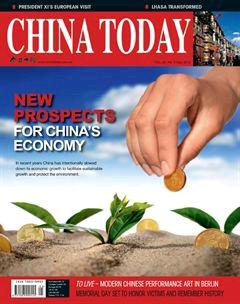The Return of the King?
By+staff+reporter+JIAO+FENG

LENOVO chose January 30, Lunar New Years Eve, when most people in China are gearing up for the Spring Festival celebrations, to announce its purchase of Motorola Mobility from Google for US $2.9 billion.
The US $2.9 billion purchase price includes US $660 million in cash and US $750 million in Lenovo ordinary shares. The remaining US $1.5 billion will be paid in the form of a three-year promissory note. In addition to more than 2,000 mobile patents, the Motorola Mobility brand and trademark portfolio, Lenovo also gets from the deal Motorolas 3,500 employees and partnerships with 50 or more operators globally.
Motorola was a pioneer of mobile terminals, and one of the first to enter the Chinese market. The Motorola 3200 came to China in 1994. In the decade that followed the company reigned supreme in the countrys burgeoning mobile phone field. By 2007 it still occupied 20 percent of the market share. This fell to 3.5 percent in 2010 and to 1.9 percent in 2012. In May of 2013, Motorola Mobility quit the Chinese market.
“Purchasing Motorola Mobility is a key step in our global smartphone strategy. It has taken us into the top three global smartphone manufacturers by volume, so contributing to our performance, enabling us to develop new pillar business and laying foundations for 10 years of sustainable growth. We are confident that on the first day after settlement of the deal we can bring the synergistic effect of this purchase into play and introduce new exciting products to the market,” Lenovo President Yang Yuanqing said in his statement on the takeover.
Yang went on to say that the acquisition would promote Lenovos leapfrog development and expansion of its smartphone business to the global market – efforts previously impeded by too few accumulated patents. In addition to the more than 2,000 patents, partnerships with 50 global operators and even more retailers, Lenovos acquisition also includes the Motorola mobile brand and its star Moto X and Moto G products, as well as 3,500 mobile phone market professionals.
Motorola remains the third biggest Android smartphone maker in both the U.S. and Latin America. Although the companys revenues do not compare with those at its peak, it nonetheless maintains a high status. Motorola has experienced a decline over the past two years. But its Moto X and Moto G series, with their appealing designs and reasonable prices, guarantee a substantial market share. Statistics show that in the fourth quarter of 2013, Lenovo ranked fourth after Samsung, Apple and Huawei in the global mobile phone market. This, however, is mainly attributable to its market share in China, as that in North America hovers at around zero. Analysts believe that the partnerships Lenovo has gained from the merger with local mobile operators will provide an indirect entry into the North American market.
Comparatively, however, the Chinese market is more appropriate for Motorolas future. As a local international enterprise, Lenovo possesses mature sales channels and profound operational experience. It is also well versed in the Chinese market. Taking into account Motorolas existing brand influence, it makes sense for Lenovo to open up new prospects, expand sales and redeem Motorolas losses through cost control in China.
Yang Yuanqing has publically stated on several occasions that Motorolas gross profit rate is far higher than that of Lenovo, the formers indebtedness attributable to its high expenditures. Lenovo, however, has impressive integration experience and is adept at squeezing profits out of a relatively meager market. Yang is consequently confident that the synergistic effect of integrating Motorola Mobility into Lenovos mobile business will enable the Moto brand to recapture China and other emerging markets.
The merger details have yet to be released, but Yang Yuanqing gave reporters an outline: “We will maintain both the Lenovo and Motorola trademarks. In the U.S., our new products will bear the ‘Motorola by Lenovo brand, making Moto the leading brand with Lenovo as the auxiliary. In China, we will adopt the ‘Lenovo and Motorola bi-brand, much like the PC, the ThinkPad and Lenovo mode.”
There is a pervasive doubt in the market about Lenovos purchase of Motorola. The bargain basement price of US$2.9 billion, compared with the US $12.5 billion that Google paid three years ago, is due to Googles retaining 90 percent of Motorola patents. High patent costs are levied on mobile phone companies that possess relatively few economically viable intellectual property rights when entering a mature market. But, on the other hand, Motorolas declining share in the smartphone market has been attributed to low innovation. So can this purchase solve the situation at root? Yang Yuanqing has yet to answer this question.
There are no positive predictions about the acquisition on the Hong Kong market. On the day the purchase was announced, Lenovos stock fell 8.21 percent – a downward trend that continued during the month that followed to almost 30 percent.
The approach of the 4G era prompts another round of reshuffling in the mobile terminal industry. Having been absent from the Chinese market for a year, Motorola will re-enter the biggest mobile phone market, in the apparent knowledge that only by seizing the Chinese market can it reign supreme once more. With its new owner at the helm, will Moto be king once more upon its return? The market waits in anticipation.

